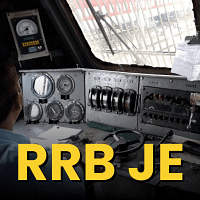Railways Exam > Railways Questions > A + BX ® AX + B, is an example of_________.a...
Start Learning for Free
A + BX ® AX + B, is an example of_________.
- a)Double displacement reaction
- b)Displacement reaction
- c)Non-reactive displacement
- d)Multiple displacement reaction
Correct answer is option 'B'. Can you explain this answer?
| FREE This question is part of | Download PDF Attempt this Test |
Verified Answer
A + BX ® AX + B, is an example of_________.a)Double displacement reac...
In a displacement reaction, we see a highly reactive element replacing a less reactive one to form a compound.
View all questions of this test
In the above reaction shown, A is a more reactive element than B, hence we have a displacement reaction happening.
Example- CuSO4 + Zn àZnSO4 + Cu
Most Upvoted Answer
A + BX ® AX + B, is an example of_________.a)Double displacement reac...
Displacement reaction
Introduction:
A displacement reaction, also known as a replacement reaction, is a type of chemical reaction in which an element or a group of elements is replaced by another element or group of elements. In this reaction, the more reactive element displaces the less reactive element from its compound.
Explanation:
In the given reaction, A is being displaced by B, which indicates that a displacement reaction is occurring. Here, element B is more reactive than element A, so it replaces A in the compound BX, resulting in the formation of AX and B as the products.
Example:
Let's take an example to understand this better. Suppose we have a reaction:
Zn + CuSO4 → ZnSO4 + Cu
In this reaction, zinc (Zn) displaces copper (Cu) from the compound copper sulfate (CuSO4). Zinc is more reactive than copper, so it replaces copper in the compound, resulting in the formation of zinc sulfate (ZnSO4) and copper as the products.
Types of displacement reactions:
Displacement reactions can be classified into several types based on the nature of the reactants and products. These include:
1. Metal displacement reactions: In these reactions, a more reactive metal displaces a less reactive metal from its compound.
2. Non-metal displacement reactions: In these reactions, a more reactive non-metal displaces a less reactive non-metal from its compound.
3. Halogen displacement reactions: In these reactions, a more reactive halogen displaces a less reactive halogen from its compound.
4. Redox displacement reactions: These reactions involve the transfer of electrons between the reactants, resulting in the displacement of one element by another.
Conclusion:
The given reaction, A BX ® AX B, is an example of a displacement reaction. In this reaction, element B is more reactive than element A, so it replaces A in the compound BX, resulting in the formation of AX and B as the products. Displacement reactions are common in chemistry and can occur between metals, non-metals, halogens, and in various other types of reactions.
Introduction:
A displacement reaction, also known as a replacement reaction, is a type of chemical reaction in which an element or a group of elements is replaced by another element or group of elements. In this reaction, the more reactive element displaces the less reactive element from its compound.
Explanation:
In the given reaction, A is being displaced by B, which indicates that a displacement reaction is occurring. Here, element B is more reactive than element A, so it replaces A in the compound BX, resulting in the formation of AX and B as the products.
Example:
Let's take an example to understand this better. Suppose we have a reaction:
Zn + CuSO4 → ZnSO4 + Cu
In this reaction, zinc (Zn) displaces copper (Cu) from the compound copper sulfate (CuSO4). Zinc is more reactive than copper, so it replaces copper in the compound, resulting in the formation of zinc sulfate (ZnSO4) and copper as the products.
Types of displacement reactions:
Displacement reactions can be classified into several types based on the nature of the reactants and products. These include:
1. Metal displacement reactions: In these reactions, a more reactive metal displaces a less reactive metal from its compound.
2. Non-metal displacement reactions: In these reactions, a more reactive non-metal displaces a less reactive non-metal from its compound.
3. Halogen displacement reactions: In these reactions, a more reactive halogen displaces a less reactive halogen from its compound.
4. Redox displacement reactions: These reactions involve the transfer of electrons between the reactants, resulting in the displacement of one element by another.
Conclusion:
The given reaction, A BX ® AX B, is an example of a displacement reaction. In this reaction, element B is more reactive than element A, so it replaces A in the compound BX, resulting in the formation of AX and B as the products. Displacement reactions are common in chemistry and can occur between metals, non-metals, halogens, and in various other types of reactions.
Attention Railways Students!
To make sure you are not studying endlessly, EduRev has designed Railways study material, with Structured Courses, Videos, & Test Series. Plus get personalized analysis, doubt solving and improvement plans to achieve a great score in Railways.

|
Explore Courses for Railways exam
|

|
Similar Railways Doubts
A + BX ® AX + B, is an example of_________.a)Double displacement reactionb)Displacement reactionc)Non-reactive displacementd)Multiple displacement reactionCorrect answer is option 'B'. Can you explain this answer?
Question Description
A + BX ® AX + B, is an example of_________.a)Double displacement reactionb)Displacement reactionc)Non-reactive displacementd)Multiple displacement reactionCorrect answer is option 'B'. Can you explain this answer? for Railways 2024 is part of Railways preparation. The Question and answers have been prepared according to the Railways exam syllabus. Information about A + BX ® AX + B, is an example of_________.a)Double displacement reactionb)Displacement reactionc)Non-reactive displacementd)Multiple displacement reactionCorrect answer is option 'B'. Can you explain this answer? covers all topics & solutions for Railways 2024 Exam. Find important definitions, questions, meanings, examples, exercises and tests below for A + BX ® AX + B, is an example of_________.a)Double displacement reactionb)Displacement reactionc)Non-reactive displacementd)Multiple displacement reactionCorrect answer is option 'B'. Can you explain this answer?.
A + BX ® AX + B, is an example of_________.a)Double displacement reactionb)Displacement reactionc)Non-reactive displacementd)Multiple displacement reactionCorrect answer is option 'B'. Can you explain this answer? for Railways 2024 is part of Railways preparation. The Question and answers have been prepared according to the Railways exam syllabus. Information about A + BX ® AX + B, is an example of_________.a)Double displacement reactionb)Displacement reactionc)Non-reactive displacementd)Multiple displacement reactionCorrect answer is option 'B'. Can you explain this answer? covers all topics & solutions for Railways 2024 Exam. Find important definitions, questions, meanings, examples, exercises and tests below for A + BX ® AX + B, is an example of_________.a)Double displacement reactionb)Displacement reactionc)Non-reactive displacementd)Multiple displacement reactionCorrect answer is option 'B'. Can you explain this answer?.
Solutions for A + BX ® AX + B, is an example of_________.a)Double displacement reactionb)Displacement reactionc)Non-reactive displacementd)Multiple displacement reactionCorrect answer is option 'B'. Can you explain this answer? in English & in Hindi are available as part of our courses for Railways.
Download more important topics, notes, lectures and mock test series for Railways Exam by signing up for free.
Here you can find the meaning of A + BX ® AX + B, is an example of_________.a)Double displacement reactionb)Displacement reactionc)Non-reactive displacementd)Multiple displacement reactionCorrect answer is option 'B'. Can you explain this answer? defined & explained in the simplest way possible. Besides giving the explanation of
A + BX ® AX + B, is an example of_________.a)Double displacement reactionb)Displacement reactionc)Non-reactive displacementd)Multiple displacement reactionCorrect answer is option 'B'. Can you explain this answer?, a detailed solution for A + BX ® AX + B, is an example of_________.a)Double displacement reactionb)Displacement reactionc)Non-reactive displacementd)Multiple displacement reactionCorrect answer is option 'B'. Can you explain this answer? has been provided alongside types of A + BX ® AX + B, is an example of_________.a)Double displacement reactionb)Displacement reactionc)Non-reactive displacementd)Multiple displacement reactionCorrect answer is option 'B'. Can you explain this answer? theory, EduRev gives you an
ample number of questions to practice A + BX ® AX + B, is an example of_________.a)Double displacement reactionb)Displacement reactionc)Non-reactive displacementd)Multiple displacement reactionCorrect answer is option 'B'. Can you explain this answer? tests, examples and also practice Railways tests.

|
Explore Courses for Railways exam
|

|
Suggested Free Tests
Signup for Free!
Signup to see your scores go up within 7 days! Learn & Practice with 1000+ FREE Notes, Videos & Tests.
























